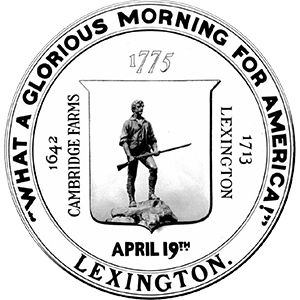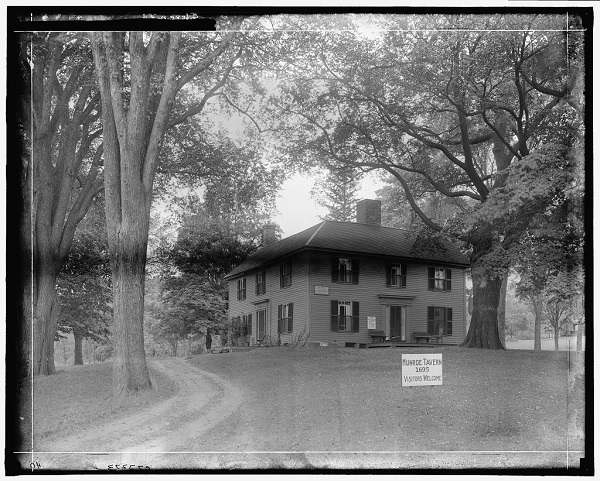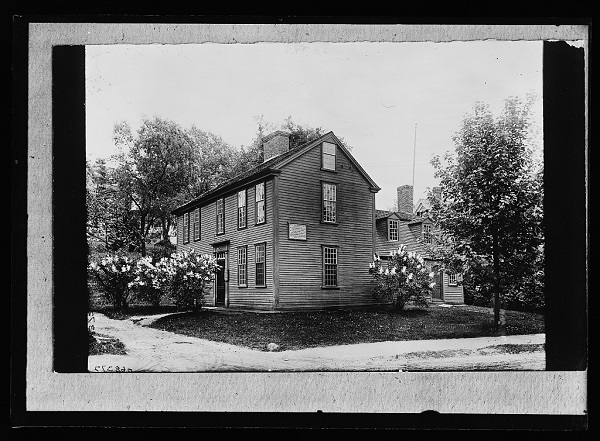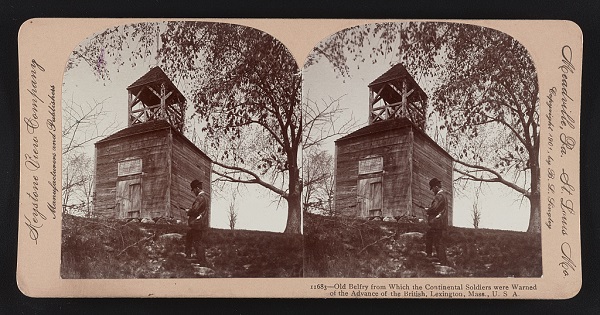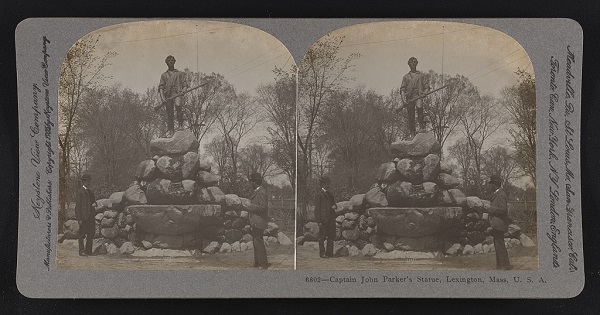Lexington, Massachusetts is a historic town in Middlesex county. First settled in the early 17th century as a part of Cambridge, Lexington was eventually incorporated as a town in the 18th century and later became famous for being the site of one of the first battles in the Revolutionary War.
The following is a timeline of the history of Lexington:
1642:
- Lexington is first settled as a farming community within the town of Cambridge.
1647:
- Lt. David Fiske builds a stone wall and well on his property on what is now Massachusetts Ave.
1689:
- The Samuel Sanderson House, a Georgian-style house, is built on what is now Massachusetts Ave.
1690:
- Old Burial Ground, also known as Colonial Cemetery, is established on Harrington Road.
1691:
- On December 15, Lexington becomes a parish in Cambridge Farms.
1700:
- The Matthew Bridge House, a Colonial-style house, is built on Marrett Road.
1709 – 1710
- Buckman Tavern, a Georgian-style building that serves as a tavern, is built on Bedford Street.
1711:
- The Lexington Common is established when the townspeople raise enough funds to purchase a 1.5 acre plot of land to use as a militia training ground.
1713:
- Lexington is incorporated as a town in the Commonwealth of Massachusetts.
1715:
- The John Mason House, a Colonial-style house, is built on what is now Massachusetts Ave.
- The first public schoolhouse is built on Lexington Common.
1716:
- The Stephen Robbins Homestead, a Georgian-style house, is built on what is now Massachusetts Ave and is later purchased by Stephen Robbins in 1781.
1722:
- Lexington Common is enlarged with the addition of another acre of land.
- The Joseph Bridge House, a Georgian-style house, is constructed on Marrett Road.
1725:
- The Joshua Underwood – Josiah Smith House is constructed on Blossom Street.
1729:
- The John Munroe – Marrett Munroe and Nathan House, a Georgian-style house, is built on Massachusetts Ave.
1730:
- The Major John Bridge House, a Greek Revival-style house, is constructed on Middleby Road.
1732:
- Dr. Robert Fiske House, a Georgian-style house, is built on Hancock Street.
- Sometime between 1732 and 1767, the Joseph Simonds House, a Georgian-style house, is built on Massachusetts Ave.
1735:
- The Munroe Tavern, a Georgian-style house, is built on what is now Massachusetts Ave by William Munroe and serves as a tavern.
1738:
- The Hancock-Clarke House, an early Georgian-style house, is built on Hancock Street.
1745:
- The Henry Harrington – Dr. Joseph Fiske House, a Georgian-style house that is also known as the Lexington Pest House, is built on East Street.
- The Jacob Whittemore House, a Georgian-style house, is constructed on Marrett Street.
1747:
- The Old Burial Ground on Harrington Road is enlarged.
1750:
- The Charles Barrett House, a Georgian-style house, is built on what is now Massachusetts Ave.
- The Benjamin Merriam – Joel Viles House, a Georgian-style house, is built on what is now Massachusetts Ave.
- The Joseph Smith – Allen, Galen House is built on Kendall Road.
- The William Woods House is built on Reed Street.
- The John Harrington House, a Georgian-style house, is built on Harrington Road.
- The Amos Muzzey House, a Georgian-style house, is built on Massachusetts Ave.
- The Micajah Locke – Franklin Alderman House, a Georgian-style house, is built on Massachusetts Ave.
1758:
- The John Chandler House, a Georgian-style house, is built by John Chandler on Lincoln Street.
1761:
- A belfry is constructed on Belfry Hill on Clarke Street behind Lt. Jonas Munroe’s House. It was later moved the Lexington Green where it remained until 1797.
1762:
- The Solomon Cutler House, a Georgian-style house, is built on Wood Street.
1765:
- The population of Lexington is 912.
1775:
- The Francis Brown House, a Georgian-style house, is built on what is now Massachusetts Ave.
- Just after midnight, on April 19, Paul Revere rides into town, followed by William Dawes shortly after, and they both stop at the Hancock-Clarke House to warn John Hancock and Samuel Adams, who were guests of Reverend Clark, that British troops are approaching.
- Around 2:30am, after Paul Revere is captured in Lincoln by British troops he is led back to Lexington but is set free when the Battle of Lexington breaks out.
- At 4:30 am, around 70 American militiamen gather on the Lexington Common to await the British troops.
- At 5 am, on April 19, British troops march into Lexington while en route to Concord and exchange gun fire with 70 American militiaman awaiting them on the Lexington Common in what has become known as the Battle of Lexington. The British troops continue on to Concord.
- From 12:30pm to 3:30pm, British troops pass back through Lexington while retreating to Boston after the Battle of Concord and the militiamen ambush them and fire upon them from the sides of what is now known as Battle Road.
1780:
- The J.Reardon – O’Reardon House is built on Vine Street. It was later demolished sometime in the 20th century.
- John Parkhurst House, a Georgian/Second Empire-style house, is built on Massachusetts Ave.
- The Isaac House Reed Homestead is built on Lowell Street sometime in the 1780s.
1786:
- The Deacon Nathan Reed House, Federal-style house, is built on Bedford Street.
1788:
- The Jonathan Harrington Jr House, a Georgian-Italianate-style house, is built on Massachusetts Ave.
- The Josiah Smith House, a Georgian-style house, is built on Blossomcrest Road.
1790:
- The Nathaniel Harrington House, a Federal-style house that serves as a parsonage for the Church of the Redeemer Episcopal Church, is built on Massachusetts Ave.
1792:
- Robbins Cemetery is established on Massachusetts Ave.
1794:
- The Levi Harrington House, a Federal-style house, is built on Harrington Road.
- The Joshua Russell – Freeborn F. Raymond House, a Colonial Revival/Federal-style house, is built on Massachusetts Ave..
1795:
- Simonds Tavern, a Federal-style building that serves as a tavern, is constructed on Bedford Street.
- The John Mulliken House, a Georgian-style house, is built on Massachusetts Ave.
- The Abel Chandler Grocery Store, a Federal-style house that also served as a grocery store, is constructed on Massachusetts Ave.
1797:
- The belfry is sold to the Parker family and is moved to Spring Street where it is used as part of a wheelwright shop.
1798:
- The Nathaniel Muliken – Sherburne, Warren House, a Georgian-style house, is built on what is now Massachusetts Ave.
- The John Williams House, a Georgian-style house, is built on Massachusetts Ave.
1799:
- On July 4, the Battle Monument, which is a granite obelisk set on a simple pedestal that is dedicated to the Battle of Lexington in 1775, is erected on Massachusetts Ave.
1800:
- The Penney – John A. Russell House, a Georgian/Federal-style house, is built on Massachusetts Ave.
- The Jonas Locke House and Cobbler Shop is constructed on Massachusetts Ave.
1802:
- The Solomon Harrington House, a Federal-style house, is built on Massachusetts Ave for Solomon Harrington.
1803:
- The Obadiah Parker – N. Ambrose Morell House, a Greek Revival/Federal-style house, is built on Massachusetts Ave.
1811:
- The Old Burial Ground on Harrington Road is enlarged.
1812:
- The British Retreat Marker, a granite monument with an inscription marking the site where a British field piece was placed during the Battle of Lexington, is erected on Massachusetts Ave.
1820:
- The Bowman Tavern, a Federal-style house that became a tavern in 1843, is constructed on Massachusetts Ave.
1821:
- Munroe Cemetery is established on Massachusetts Ave.
1822:
- The Lexington First Normal School is built on Bedford Street.
1824:
- General Marquis de Lafayette visits Lexington during his tour of the United States and is welcomed to Lexington with an arch that read: “Welcome, friend of America, to the birth place of American liberty.”
1828:
- The Eli Robbins Store, a brick building that serves as a store, is built on Massachusetts Ave.
1830:
- Burr and Chittenden Clockmaker Company Worker Housing, a Federal/Greek Revival-style building, is constructed on Bedford Street.
1834:
- The Stone Building, also known as the Cary Memorial Library, is built on Massachusetts Ave.
- The Amos Muzzey House is moved to Vine Brook Road.
1835:
- On April 20, seven of the eight men killed at the Battle of Lexington are moved from the Old Burying Ground to a tomb under the Battle Monument on Massachusetts Ave. A ceremony is held at the monument to mark the occasion.
1840:
- The Robinson Block, a Colonial/Greek Revival-style commercial building, is constructed on Massachusetts Ave.
- The Follen Community Church is built on Massachusetts Ave.
1846:
- The General Samuel Chandler House, an Italian villa-style house, is built on Goodwin Road.
- The Lexington-West Cambridge Railroad Depot is built on Depot Square.
- The First Lexington Town Hall and High School is built on Massachusetts Ave.
1847:
- The First Parish Church is built on Harrington Road.
1850:
- The Robbins Fence, a cast-iron fence, is built around the old Stephen Robbins Homestead on Massachusetts Ave.
- The population of Lexington is 1893.
1852:
- The Franklin Warren Schoolhouse is built on Lincoln Street.
- The Bowditch – Tidd District Schoolhouse is built on Larchmont Lane.
1857:
- The Hancock Engine Company No. 2 Fire House is built on Fletcher Ave.
1860:
- The population of Lexington is 2,329.
1865:
- Theodore Parker Birthplace Marker, a granite marker, is erected on the site of the old Parker homestead on Spring Street.
1870:
- Dr. William J. Currier House and Office, a Greek Revival-style building, is constructed on Muzzey Street.
- The John House Chisholm and Harness Shop is constructed on Massachusetts Ave.
- The population of Lexington is 2,277.
1875:
- The East Lexington Post Office – Childs Grocery Store, a Greek Revival-style commercial building serving as both a post office and grocery store, is constructed on Massachusetts Ave.
- The Central Fire Station is built on Hayes Lane.
1880:
- The population of Lexington is 2,460.
1882:
- The M.H. Merriam and Company factory building is constructed on Oakland Street.
- The Matthew H. Merriam Shoe Bindings Manufactory is built on Oak Street.
1884:
- The Lexington Meetinghouse Marker is erected on Massachusetts Ave on the site of the first three meetinghouses built in Lexington. The marker is a single block of red Jonesboro granite on a base of Fox Island granite in the shape of a reading desk with a closed book on it.
- The Battle Line Boulder, a boulder that marks the end of the line formed by the Minute Men at the Battle of Lexington, is established on Massachusetts Ave.
- The Granite Cannon Monument, a stone cannon that marks the spot where British General Earl Percy came to the relief of his fleeing army at the Battle of Lexington, is erected on Massachusetts Ave.
1885:
- The Hayward Well Monument, a granite marker commemorating the site where American soldier James Hayward fought a British soldier on April 19, 1775, is erected on Old Massachusetts Ave.
- Bluff Monument, a granite marker commemorating a rally point where the British troops attempted to fend off the Minute Men pursing them after the Battles of Lexington and Concord, is established on Old Massachusetts Ave.
1886:
- The “What a Glorious Morning” Memorial, a granite plaque commemorating the phrase that Samuel Adams reportedly said on the morning of the Battle of Lexington, is established on a stone wall on Meriam Street.
- The Church of Our Lady Redeemer Episcopal Church is built on Meriam Street.
1888:
- The Lexington Pumping Station Engineer’s House is constructed on Lincoln Street.
1890:
- The Amos Muzzey House is moved to Forest Street.
- The population of Lexington is 3,197.
1891:
- The Hancock School, a Romanesque Revival-style school building, is constructed on Forest Street.
- The old belfry is acquired by the Lexington Historical Society and moved to the Hancock School on Clarke Street.
- On May 13, the First Baptist Church on Meriam Street is destroyed in a fire.
1892:
- The Hancock Congregational Church is built on Massachusetts Ave.
1893:
- The First Baptist Church is rebuilt on Massachusetts Ave.
1894:
- The Warren E. Sherburne House is built on Percy Road.
- The Byron Russell Blacksmith shop is constructed on Massachusetts Ave.
- The Benjamin Merriam – Joel Viles House is moved to Woburn Street.
1896:
- The Lexington Historical Society purchases the Hancock-Clark House and moves it across the street to save it from being demolished.
- The First Lexington Town Hall and High School is condemned by the state inspector.
1898:
- The town of Lexington accepts a bequest of $10,000 from Francis B. Hayes for a drinking fountain/watering place for horses, cattle and dogs.
- On August 4, a contract is signed with Boston sculpter Henry Kitson to create the drinking fountain.
- The Theodora Robinson Kindergarten is constructed on Forest Street.
1899:
- The Minuteman Statue fountain, which features a life-size bronze statue of a colonial minuteman (believed to be Captain Parker) standing on a base of fieldstones, is erected on the Lexington Green on Massachusetts Ave. The statue is designed by Henry Kitson and faces the route of the British advance. The front of the statue features a basin where water collects and the rear of the statue features a smaller basin and a bronze plaque above it.
- The Lexington and Boston Street Railway Co. Powerhouse is constructed on Bedford Street.
1900:
- The Lexington Railroad Bridge is built on Bedford Street.
- On April 19, the Minuteman Statue fountain is officially dedicated on the 125th anniversary of the Battle of Lexington.
- The population of Lexington is 3,831.
1902:
- The John Chandler House is purchased by a blacksmith named Stephen Broughall and moved to Lincoln Street to avoid being demolished due to the Cambridge Water Basin project.
- The First Lexington Town Hall and High School is purchased by W.E. Denham and moved to Vine Street.
- The Muzzey High School is built on the former site of the First Lexington Town Hall and High School on Massachusetts Ave.
1903:
- The Lexington Savings Bank is constructed on Massachusetts Ave.
1904:
- The Munroe Primary School – Munroe Junior High School is constructed on Massachusetts Ave.
1905:
- The Lexington Railroad Bridge is built on Grant Street.
1906:
- The Cary Memorial Library, a Craftsman-style building, is constructed on Massachusetts Ave.
- The Thomas H. Breslin – Stone Store, a commercial building constructed out of fieldstones, is built on Massachusetts Ave.
1909:
- On June 20, the old belfry is destroyed during a windstorm.
1910:
- The Old Belfry Monument, a replica of the original old belfry, is erected on Clarke Street.
- The Belfry Site Boulder, a boulder with a bronze plaque, is erected on the site of the original belfry on Massachusetts Ave and a dedicated ceremony is held on October 19.
- Whipple Hill Farm is constructed on Summer Street.
- The population of Lexington is 4,918.
1912:
- The Lexington Lumber Company is built on Bedford Street.
- The Adams School, a classical revival-style school building, is constructed on Massachusetts Ave.
1913:
- The town of Lexington purchases Buckman Tavern.
- Boston Edison Company Building No. 34 is constructed on Grant Street to supply electricity to the town.
- Temple B’nai Jacob is constructed on Sylvia Street.
1914:
- The town of Lexington leases Buckman Tavern to the Lexington Historical Society to operate as a historic house museum.
1915:
- The Reverend Charles Follen Memorial, a granite monument with a bronze plaque dedicated to Rev. Follen, is erected on Massachusetts Ave.
1916:
- The Viano Block – Theater Block, a Classical Revival-style commercial building, is constructed on Massachusetts Ave.
1920:
- Sacred Heart Roman Catholic Church Rectory is constructed on Follen Road.
- The population of Lexington is 6,350.
1922:
- The Ribock Block, a commercial block consisting of five small stores, is constructed on Massachusetts Ave.
1924:
- Sometime between 1924 and 1926, the John Williams House is moved to Curve Street.
- Granfield’s Cafe and Market is constructed on Marrett Road.
1925:
- The Aldrich Block, a Colonial-style commercial building, is constructed on Massachusetts Ave.
1927:
- The Isaac Harris Cary Memorial Hall, a Colonial Revival-style building that serves as a meeting hall, is constructed on Massachusetts Ave.
- The Colonial Building, a commercial block, on Massachusetts Ave.
- Wards A – H are constructed at the Metropolitan State Hospital on Trapelo Road.
- The Lexington Town Hall Office Building, a Colonial Revival-style government building, is constructed on Massachusetts Ave.
1928:
- The power plant and quadrangle are built at the Metropolitan State Hospital on Trapelo Road.
- Woolworth’s Department Store is constructed on Massachusetts Ave.
1929:
- A. A. Marshall and Sons Undertakers Building is constructed on Massachusetts Ave.
- The Sacred Heart Roman Catholic Church is built on Follen Road.
1930:
- The Lexington Trust Company Building, a Colonial Revival-style building that serves as a bank, is constructed on Massachusetts Ave.
- The population of Lexington is 9,467.
1931:
- The Franklin School is built on Stedman Road.
1932:
- The Aiden Lassell Ripley House and Art Studio is constructed on Follen Road.
1934:
- The Lexington Railroad Bridge is built over Tophet Swamp.
1935:
- The incinerator and St. Nicholas Chapel are built at Metropolitan State Hospital on Trapelo Road.
- The Hood Creamery Store is constructed on Massachusetts Ave.
1937:
- The United States Post Office – Lexington Main is built on Massachusetts Ave.
1940:
- Sometime in the 1940s, the old Stephen Robbins House is moved to another location on Massachusetts but the Robbins Fence remains in its original location.
- The population of Lexington is 13,187.
1941:
- The Joshua Russell – Freeborn F. Raymond House is moved to Vine Street.
1946:
- The Lexington Fire Headquarters is constructed on Bedford Street.
1948:
- The Lexington Minute Men of 1775 Memorial, designed by Bashka Paeff, is erected on Bedford Street.
1950:
- The Benjamin Wellington Historic Marker is erected on Follen Road.
- The East Lexington Fire Station is constructed on Massachusetts Ave.
- The population of Lexington is 17,335.
1953:
- The Lexington Arts and Crafts Society Headquarters Building is constructed on Waltham Street.
1954:
- New England Telephone and Telegraph Company Office is constructed on Waltham Street.
- The Church of Our Lady Redeemer Episcopal Church purchases land across the street from its location on Meriam Street and makes plans to build a new and much larger church.
1955:
- The Maria Hastings Elementary School is constructed on Crosby Road.
1956:
- The Manhattan Building, a commercial block, is constructed on Waltham Street.
- The new Church of Our Redeemer Episcopal Church is constructed on Meriam Street.
1957:
- The Lexington Town Office Building, a Colonial Revival-style building, is constructed on Massachusetts Ave.
- Sacred Heart Roman Catholic Church Parish Center is constructed on Massachusetts Ave.
1960:
- The Joseph Estabrook Elementary School is built on Grove Street.
- The Lexington Visitor Information Center is built on Massachusetts Ave.
- The population of Lexington is 27,691.
1961:
- The Boston and Maine Railroad Bridge, the Route 4 Bridge and the Route 2A Bridge are built over Route 128.
- The Lexington Furniture Store is built on Massachusetts Ave.
1964:
- The Bridge Elementary School is built on Middlebury Road.
1965:
- The Bowman Elementary School is built on Philip Road.
- Leader Federal Savings and Loan Association Building is constructed on Massachusetts Ave.
1966:
- The Adams Building is constructed on Meriam Street.
1970:
- The population of Lexington is 31,886.
1973:
- The Lexington Mews, a Colonial Revival-style commercial building, is constructed on Muzzey Street.
1974:
- The Lexington Historical Society purchases the land where the Hancock-Clark house was originally located and moves the house back to its original location on Hancock Street.
- The Museum of Our National Heritage is constructed on Marrett Road.
1976:
- The Battle Road Visitor Center is constructed on Airport Road.
1980:
- The ICF House is built on Concord Ave for the Metropolitan State Hospital.
- The population of Lexington is 29,479.
1990:
- The population of Lexington is 28,974.
1991:
- Father McCabe Memorial Garden is established on Follen Road.
2000:
- The population of Lexington is 30,355.
2010:
- The population of Lexington is 31,394.
Sources:
“Lexington Reconnaissance Report.” Mass.gov, Massachusetts Department of Conservation and Recreation, mass.gov/doc/lexington-1/download
“April 19, 1775.” NPS.gov, nps.gov/mima/learn/historyculture/april-19-1775.htm
“Lexington and Concord Battle Facts and Summary.” American Battlefied Trust, battlefields.org/learn/revolutionary-war/battles/lexington-and-concord
“Lexington History Resources.” Town of Lexington Massachusetts, lexingtonma.gov/lexington-history-resources
“About the Town of Lexington.” Town of Lexington Massachusetts, lexingtonma.gov/about
MACRIS, Massachusetts Cultural Resource Information System, Massachusetts Historical Society, mhc-macris.net/

